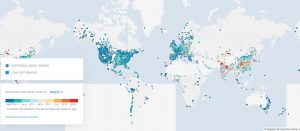By Millie Chu Baird, Associate Vice President, Office of the Chief Scientist
Harnessing data for good has been at the heart of EDF science for decades. Whether we’re identifying gas leaks underground or methane leaks from the air, we want to use the data we collect and analyze to help the planet and the people who inhabit it. Sometimes, that means turning it over to another organization that can do even more with it.

One of the keys to fighting air pollution inequity is data transparency—ensuring that as wide a range of people as possible have access to as much of it as possible.
When EDF embarked on our air pollution work several years ago, we partnered with Google, whose Street View Cars drove 23,000 kilometers in Oakland, CA, collecting 3 million unique measurements of black carbon (BC) particles, nitric oxide (NO) and nitrogen dioxide (NO2). This was an astounding dataset at the time, and it took careful analysis and thoughtful work with critical community partners, who helped us better understand the hot spots the data revealed.
Those research partners—the West Oakland Environmental Indicators Project—showed us just how critical getting data into the hands of a robust, engaged community is to turning insights into the kind of action that will improve air pollution, which kills an estimated 6.5 million people every year. They provided essential local insights to help our scientists interpret the data and draw relevant conclusions. This collaboration, built on long-term engagement and trust and a recognition of their role in community organizing in data analysis, was critical to informing policy action.
Taking advantage of multiple types of pollution and health data and a new legal mandate from the state legislature, the West Oakland Environmental Indicators Project worked with community members and the Bay Area Air Quality Management District to co-create the West Oakland Community Emissions Reduction Plan, turning air pollution data in action.
Merging our data with a robust, community platform
That’s why I’m excited that OpenAQ will be using the datasets we’ve collected and analyzed over the last 5 years. They’ve invested in and continue to build and maintain a robust platform for sharing data from a variety of sources, including government monitors, PurpleAir, HabitatMap and Carnegie Mellon University.
Through workshops in various countries around the world—currently held online—they’ve developed and nurtured a community of researchers and dedicated activists who can access air pollution information in one central location. After all, this air quality sensor revolution is only a revolution if people can see the data. It’s foundational to the ability to take action–whether in West Oakland, California or on the other side of the world.
This data they present isn’t just for air quality scientists. Their dashboards are accessible enough for those with even a casual interest in air pollution to read and understand. For more technical users, OpenAQ provides an API to pull data for analysis.
As momentum grows to tackle the global air pollution crisis, groups like OpenAQ will be instrumental in helping EDF drive clean air action by shining a light on air quality at a scale and scope never seen before. We hope you’ll spend some time on their platforms, explore the data, and share it with your community.
